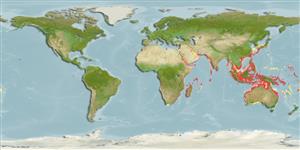>
Ovalentaria/misc (Various families in series Ovalentaria) >
Ambassidae (Asiatic glassfishes)
Etymology: Ambassis: Derived from Greek, anabasis = climbing up (Ref. 45335).
More on author: Lacepède.
Issue
Considered as a nomen dubium by Anderson & Heemstra, 2003 (Ref. 50956:200); no types known and illustration and description were found undiagnostic.
Environment: milieu / climate zone / depth range / distribution range
Ecología
marino; agua dulce; salobre demersal; pH range: 7.2 - 8.2; anfidromo (Ref. 51243). Tropical; 22°C - 28°C (Ref. 12468)
Indo-West Pacific: South and East Africa, including Mauritius, Réunion, Madagascar and Seychelles, to Philippines, north to India, south to northern Australia (Ref. 33390). Extends south on African coast at least to Algoa Bay, South Africa (Ref. 4318).
Tamaño / Peso / Age
Maturity: Lm ? range ? - ? cm
Max length : 16.0 cm TL macho / no sexado; (Ref. 4180)
Espinas dorsales (total) : 7 - 8; Radios blandos dorsales (total) : 8 - 10; Espinas anales: 3; Radios blandos anales: 8 - 10.
Fairly common in marine and fresh waters (Ref. 4180); found in shallow waters; common in estuaries; may enter lower reaches of rivers. Can tolerate fresh water only within a narrow temperature (23-26°C). Feeds mainly at night on crustaceans, but also takes small fishes, fish eggs and larvae in estuaries (Ref. 7248). Marketed dried, salted and fresh (Ref.97399).
Life cycle and mating behavior
Maturities | Reproducción | Spawnings | Egg(s) | Fecundities | Larva
Maugé, L.A., 1986. Ambassidae. p. 297-298. In J. Daget, J.-P. Gosse and D.F.E. Thys van den Audenaerde (eds.) Check-list of the freshwater fishes of Africa (CLOFFA). ISNB, Brussels; MRAC, Tervuren; and ORSTOM, Paris. Vol. 2. (Ref. 4180)
IUCN Red List Status (Ref. 130435)
Threat to humans
Harmless
Human uses
Pesquerías: escaso valor comercial; carnada: occasionally
Herramientas
Special reports
Download XML
Fuentes de Internet
Estimates based on models
Preferred temperature (Ref.
123201): 24.2 - 29.1, mean 28.1 °C (based on 1254 cells).
Phylogenetic diversity index (Ref.
82804): PD
50 = 0.5000 [Uniqueness, from 0.5 = low to 2.0 = high].
Bayesian length-weight: a=0.01318 (0.00743 - 0.02338), b=3.01 (2.86 - 3.16), in cm total length, based on LWR estimates for this species & Genus-body shape (Ref.
93245).
Nivel trófico (Ref.
69278): 3.9 ±0.56 se; based on food items.
Generation time: 0.9 ( na - na) years. Estimated as median ln(3)/K based on 1
growth studies.
Resiliencia (Ref.
120179): Alto, población duplicada en un tiempo mínimo inferior a 15 meses (k=1.20).
Fishing Vulnerability (Ref.
59153): Low vulnerability (12 of 100).
